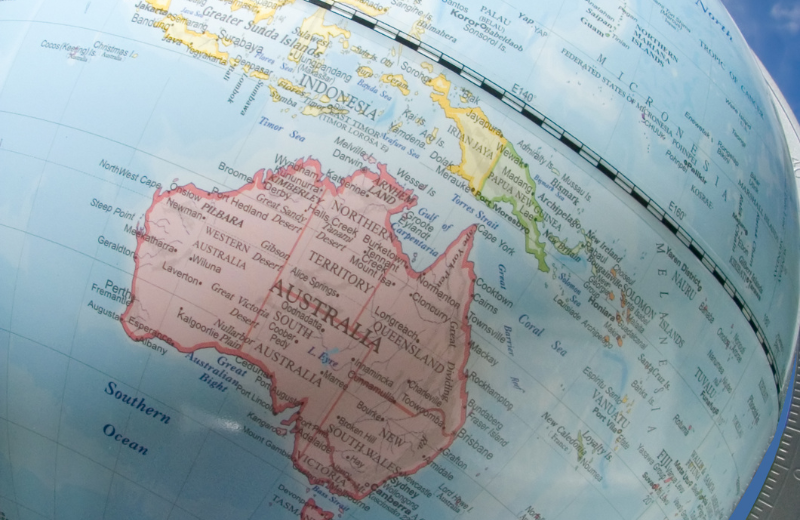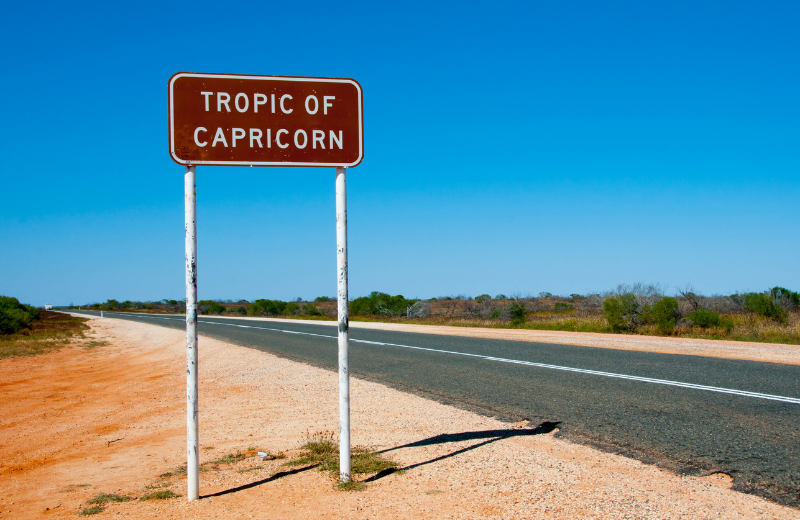Have you ever wondered why certain parts of the world experience such unique climates and diverse ecosystems? Or perhaps you're curious about the imaginary lines on the globe that play a significant role in our understanding of Earth's geography. One such line is the Tropic of Capricorn, a fascinating and important concept in the study of the planet. This guide takes you through everything you need to know about the Tropic of Capricorn, from its meaning and location to the countries it crosses and the reasons it’s so significant.
Jump to:
- What is the Tropic of Capricorn?
- How Did the Tropic of Capricorn Get its Name?
- Why is the Tropic of Capricorn Important?
- Where is the Tropic of Capricorn?
- Tropic of Capricorn: Countries and Continents
- What’s the Difference Between the Tropic of Cancer and the Tropic of Capricorn?
- Interesting Facts About the Tropic of Capricorn
- Frequently Asked Questions About the Tropic of Capricorn
- Study Astronomy for £29
Recommended for you!
Best SellersWhat is the Tropic of Capricorn?
The Tropic of Capricorn is an imaginary line that circles the Earth at approximately 23.5 degrees south of the Equator. It marks the southernmost point where the Sun can be directly overhead at noon. This phenomenon occurs once a year during the December solstice, around the 21st of December, when the Sun reaches its southernmost point in the sky.
How Did the Tropic of Capricorn Get its Name?

The name “Tropic of Capricorn” has an interesting history. It comes from the constellation Capricornus, which the Sun was in when it reached its southernmost point thousands of years ago during the December solstice. Although the Earth’s axial precession has since shifted the Sun’s position relative to the constellations, the name has remained.
Why is the Tropic of Capricorn important?
The Tropic of Capricorn plays a role in defining the Earth’s tropical zone, which has a significant impact on global climate patterns. Understanding the Tropic of Capricorn also helps us understand the Earth’s tilt and the changing seasons, which are fundamental aspects of geography and astronomy.
Where is the Tropic of Capricorn?
The Tropic of Capricorn runs across the Southern Hemisphere, cutting through several continents and oceans. If you were to look at a world map, you would see this line crossing South America, Africa, and Australia. This line of latitude also passes through a few significant
Tropic of Capricorn: Countries and Continents

The Tropic of Capricorn crosses three major continents: South America, Africa, and Australia. Each continent has unique geographical features and climates shaped by its proximity to this important latitude. Below is an overview of the countries that the Tropic of Capricorn passes through on each continent.
South America
In South America, the Tropic of Capricorn runs through the continent’s southern regions, contributing to a diverse range of climates from tropical rainforests to arid plains. Here are the countries it crosses:
- Brazil: The Tropic of Capricorn cuts through southern Brazil, influencing a climate that ranges from tropical in the north to temperate in the south. Key cities near this line include São Paulo and Curitiba.
- Paraguay: A landlocked country with a subtropical climate, the Tropic of Capricorn passes through Paraguay’s Chaco region, known for its dry forests and savannas.
- Argentina: In Argentina, the Tropic of Capricorn runs through the northern region, including the Gran Chaco and the city of Salta, bringing a mix of subtropical and semi-arid climates.
Africa
Africa is the only continent where the Tropic of Capricorn crosses both the mainland and an island nation. The line influences diverse ecosystems, from deserts to coastal areas. Here are the African countries it passes through:
- Namibia: The Tropic of Capricorn runs through central Namibia, including the Namib Desert, and influences the country’s predominantly arid climate.
- Botswana: Crossing the southern part of Botswana, the Tropic of Capricorn passes through the Kalahari Desert, contributing to the country’s semi-arid conditions.
- South Africa: The Tropic crosses the northern provinces of South Africa, including Limpopo, known for its wildlife reserves like the Kruger National Park and a subtropical climate.
- Mozambique: The Tropic of Capricorn cuts through southern Mozambique, particularly near Inhambane, affecting the region’s tropical to subtropical coastal climate along the Indian Ocean.
- Madagascar: This large island nation off Africa’s southeastern coast is also crossed by the Tropic of Capricorn, influencing the unique biodiversity of its southern regions, which experience a tropical climate with distinct wet and dry seasons.
Australia
Australia is one of the more prominent countries crossed by the Tropic of Capricorn. In fact, a large portion of the continent lies within this tropical zone, which is why much of Australia has such a warm climate.
Australia’s Great Barrier Reef, a world-famous natural wonder, is located close to the Tropic of Capricorn. This proximity influences the warm waters and diverse marine life that thrive in the region. The reef is one of the most biodiverse ecosystems on the planet, partly thanks to its location in the tropics.
What’s the Difference Between the Tropic of Cancer and the Tropic of Capricorn?
The Tropic of Capricorn has a northern counterpart known as the Tropic of Cancer. While the Tropic of Capricorn lies 23.5 degrees south of the Equator, the Tropic of Cancer is positioned 23.5 degrees north of the Equator.
Interesting Facts About the Tropic of Capricorn

Here are some intriguing facts that highlight the uniqueness and geographical significance of the Tropic of Capricorn:
- Mauritius lies just north of the Tropic of Capricorn: Although not crossed by the Tropic itself, the island nation of Mauritius is one of the closest significant landmasses, influenced by the tropical climate typical of areas near this latitude.
- Alice Springs, Australia, is a town directly on the Tropic of Capricorn: This central Australian town is one of the few significant settlements where the Tropic passes directly through, highlighting its unique geographical position in the heart of the Outback.
- The Tropic of Capricorn passes through ten countries: These countries are Brazil, Paraguay, Argentina, Namibia, Botswana, South Africa, Mozambique, Madagascar, Australia, and Chile, each experiencing varied climates due to their location along this latitude.
- The Tropic of Capricorn shifts slightly over time: Due to the Earth’s axial precession, the exact position of the Tropic of Capricorn moves slightly each year, currently drifting at a rate of about 15 metres per year.
- The Tropic of Capricorn defines the southern boundary of the tropics: Together with the Tropic of Cancer to the north, it delineates the area on Earth known as the tropics, which experiences the most direct sunlight and generally warmer temperatures year-round.
Recommended for you!
Best SellersFrequently Asked Questions About the Tropic of Capricorn
What is the exact latitude of the Tropic of Capricorn?
The Tropic of Capricorn is located at approximately 23.5 degrees south of the Equator. This line of latitude is one of the five major circles of latitude that divide the Earth and is specifically important for marking the southernmost point where the Sun can be directly overhead.
Why does the Tropic of Capricorn shift over time?
The Tropic of Capricorn shifts slightly over time due to the phenomenon known as axial precession, which is the gradual shift in the orientation of Earth’s axis of rotation. This causes the position of the Tropic of Capricorn to move at a rate of about 15 metres per year.
Which countries are crossed by both the Tropic of Capricorn and the Equator?
The only country crossed by both the Tropic of Capricorn and the Equator is Brazil. This unique geographical position gives Brazil a diverse climate, ranging from tropical in the north to more temperate conditions in the south.
How does the Tropic of Capricorn affect climate?
The Tropic of Capricorn influences the climate of the regions it crosses by defining the southern boundary of the tropical zone. Areas near this latitude typically experience warm temperatures year-round, with distinct wet and dry seasons in some regions.
Are there any major cities located on the Tropic of Capricorn?
There are several significant cities and towns located near the Tropic of Capricorn. Alice Springs in Australia is one example, lying directly on this line of latitude. Other notable cities close to the Tropic include São Paulo in Brazil and Asunción in Paraguay.
What is the spiritual meaning of the Tropic of Capricorn?
For many cultures, the Tropic of Capricorn holds spiritual significance, particularly during the December solstice when the Sun is directly overhead. This time of year is often associated with themes of renewal, reflection, and the celebration of natural cycles.
Study Astronomy for £29
If you've found this exploration of the Tropic of Capricorn intriguing and want to learn more about topics like these, consider expanding your knowledge with the Astronomy Diploma Course offered by Centre of Excellence. This course is perfect for anyone interested in learning more about the wonders of our universe, and it’s currently available at a discounted price of just £29.













